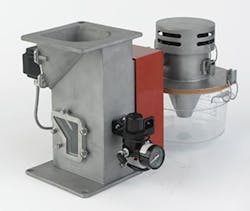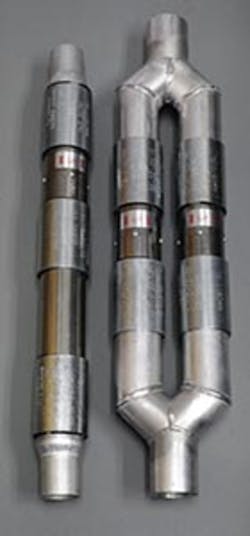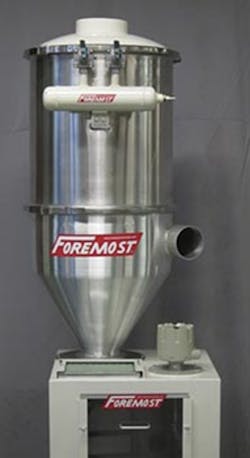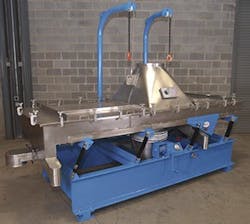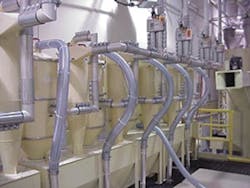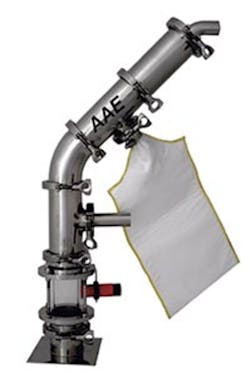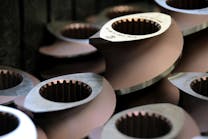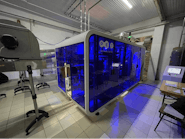The inevitability of dust and fines isn't something that plastics processors can sweep under the rug when it comes to conveying.
Even with filters, unwanted materials can get into air lines and vacuum pumps, which can cause production delays. Dust-control equipment makers have developed new products to address the problem.
Kongskilde
With this month's addition of the AW 15, Kongskilde has expanded its AirWash line. Using an integrated blower, it conveys a variety of materials, including PP, PET, PE and nylon, from granulators, mixers and other process equipment. The vacuum system moves the material to a unit where it's filtered, then discharges the clean material to another receptable. Hourly throughputs for the AirWash line vary by model, but can exceed 2,800 pounds.
With an hourly throughput of 200 pounds, the AW 15 has a 1.5-horsepower blower and 0.5-horsepower rotary valve. The smallest-capacity model in the AirWash line, it stands 8.5 feet high.
Pelletron
Pelletron launched its updated C-20 DeDuster in June. Its new features include a stainless-steel agitator, a variable-speed stepper motor, an upgraded cyclone for dust separation and a window for viewing product flow.
The cast stainless-steel body is a shift from a welded body, President and CEO Heinz Schneider said. "This helps to reduce the price dramatically by more than 20 percent."
With the variable-speed motor, "we can actually control the product flow more precisely because injection molding machines, they work with all amounts of product — say 5 pounds an hour up to 100 pounds per hour," Schneider said.
The device, the smallest in the Pelletron line, is easy to install, and can be used in clean rooms, which is a plus for a lot of customers, Schneider said. It's applicable for use with injection molding machines and extruders.
The device is capable of processing up to 100 pounds an hour of dry, granular material. The 20-pound C-20 requires just 10.5 inches of installation height between the hopper loader and the inlet hopper of an injection molding machine.
Novatec
Novatec's air-flow regulator controls the speed of air flowing through receivers in material conveying lines.
When the workload is lighter, the air tends to speed up, because it's easier for the pump to move the air. That increases dust generation. The air-flow regulator keeps the air from moving too fast. "It brings that material speed back down, and it prevents that excessive dust from being created," said Jim Zinski, VP of product technology for Novatec.
It's easy to install and doesn't require any control interface or maintenance, Zinski said.
Another new, optional dust-control device is a variable-speed conveying control setup. The user can select the speed by the individual station. It also includes a variable-speed pump control on the vacuum pump. "When a station [is] loading, the control would tell the pump what speed to run at to get the appropriate speed for that station," he said.
Zinski said that the system design in general, while not new, is becoming more popular. "A lot of the dust is falling intact and sliding to an outlet. You add all these individual tools together when you're designing a system, and if the end result is each one incrementally improves the performance, together they become very effective."
Size Reduction Specialists
Size Reduction Specialists has modified the tumbler section on its Model 0308 in the DFS series of systems for dust and fines removal. Made for press-side use, the compact machine can process 25 pounds of regrind in an hour. It removes dust and small particles generated by screen-type granulators and filled engineered resins that shatter during granulation, President and CEO Don Maynard said. With the modification to the tumbler, the material is held longer to remove more fines.
The DFS allows for a higher percentage of regrind to be used. "Fines removal at the press eliminates the unnecessary movement associated with central dust removal and reduces the possibility of contamination," he said.
It can be mounted on a granulator, and the perforated screen is available in four sizes: 0.0625 inch, 0.09375 inch, 0.125 inch and 0.78125 inch.
"Processing engineers are generally reluctant to use regrind in their process, especially for high-quality parts," Maynard said. "By using a press-side dust- and fine-removal system, it will provide engineers with clean and quality regrind for their processes."
Foremost Machine Builders
Foremost Machine Builders has completed initial testing, marketing and production of its filtered receiving cyclones. The units incorporate the air/plastic separation abilities of a cyclone with the filter bag/compressed air blow-down features of a dust collector, assistant sales manager Drew Schmid said.
The filtered receiving cyclone line includes units that can work with a variety of blowers with a range of sizes, including 5-inch and 6-inch outer diameters.
Material is conveyed out a of scrap granulator through a blower into the filtered receiving cyclone, Schmid said. The exhaust air is filtered through six 100-micron bags, and the dust clings to the bags. The compressed air blow-down feature cleans the bags, keeping the dust in with the material, where it can be reprocessed.
The compact design of the filtered receiving cyclone replaces the traditional cyclone, which has a side-mounted filter head that takes up much more floor space, he said. Also, the filtered receiving cyclone is self-cleaning.
Witte
Witte's 400-series pellet classifier is a constantly evolving piece of equipment with upgrades based on feedback from its plastics processing customers, company President Tyson Witte said. More recently, Witte changed the processing arrangement so that air classification step is now the first step in what Witte called "a better design all around."
The new process begins with air classification, allowing for the removal of any minus 20 mesh fines, including any statically held fines. Next, comes the removal of ribbons, streamers or angel hair. Fines separation takes place on a wire mesh or perforated screen; and, finally, a perforated screen is used for a third, oversize separation.
Reconfiguring the machine so that air classification is first prevents any of the small fines from blinding or clogging the fines screen, which is next in the process, Witte said.
Comet Plastic Equipment
Last October, Comet Plastic Equipment shipped its first cyclone vacuum receivers after developing them for a customer experiencing problems with clogged screen filters.
"We designed them for one of our automotive customers who was having trouble with regrind dust," said Tom Rajkovich, sales manager at Comet Plastic Equipment. "The regrind dust was clogging his vacuum receiver screens."
Traditional filterless vacuum receivers require stainless-steel screens to filter the air and resin moving through a central vacuum conveying system. However, when working with recycled plastics or regrind, dust can frequently plug the screens, forcing the need for frequent cleaning.
Comet so far has manufactured 15 cyclone vacuum receivers for the automotive industry client, and based on its success, Comet is prepared to offer them to other clients.
Instead of using a screen to filter the air and resin passing through the vacuum receiver, Comet places a cyclone unit on top of the vacuum receiver. The resin comes in at an angle and then spins around in the chamber. The fines and dust are carried away to a fines filter near the air pump, and the heavier particles of plastic and regrind drop down into a blender.
The cyclone eliminates the need for the maintenance associated with cleaning screens, which are required by a standard vacuum receiver, Rajkovich said.
Una-Dyn
Universal Dynamics is offering a PowerFilter option on its DustMaster devices, which are used to collect dust and protect pumps in vacuum conveying systems, President Bill Goldfarb said.
Depending on its configuration, the PowerFilter can include either four or six polyester felt bags on cages. While under vacuum, they collect dust; once the conveying cycle is complete, a jet of compressed air releases the dust into a collection area. Also, when pumps are inactive, the DustMaster initiates a pulse of air for cleaning.
Compared to using canisters, the PowerFilters are significantly less time-consuming and costly to change. They require no conveying downtime, and have no seals that wear. Goldfarb said that typical payback is less than six months.
Advanced Auxiliary Equipment
Advanced Auxiliary Equipment (AAE) recently updated its CAD-2 material loader so that it can process both virgin and regrind materials while removing the dust from the regrind. Once both materials have been loaded, they are blended in the sight glass, said company founder Donald Rainville
AAE as recently as last month was updating the hole sizes in the separator perforations to accommodate different types of resins, Rainville said. The CAD-2 comes in food-grade Class 3A stainless steel and features a dust-tight, clamp-on assembly. It has a large bag that can be mounted remotely that collects fines removed by a separator.
A three-in-one wand offers the power of an eight-port venturi. Users can add a fluidizing port or a vibrator to handle materials that are difficult to convey.Options include hopper adapters, dry fill adapters and a no-load alarm.
Allan Gerlat, correspondent
agerlat@plasticsmachinerymagazine.com
For more information
Advanced Auxiliary Equipment Inc.,Mathews, Va., 804-725-1950, www.dryers-loaders-blenders.com
Comet Plastic Equipment,Riviera Beach, Fl., 800-328-5088, www.cometpe.com
Foremost Machine Builders Inc.,Fairfield, N.J., 973-227-0700, www.foremostmachine.com
Kongskilde Industries Inc.,Hudson, Ill., 309-452-3300, www.kongskilde-industries.com/Industry
Novatec Inc.,Baltimore, 410-789-4811, www.novatec.com
Pelletron Corp.,Lancaster, Pa., 717-293-4008, www.pelletroncorp.com
Size Reduction Specialists,East Lansing, Mich., 517-333-2605, www.srscorp.com
Universal Dynamics Inc.,Woodbridge, Va., 703-490-7000, unadyn.piovan.comWitte Co. Inc.,Washington, N.J., 908-689-6500, www.witte.com
